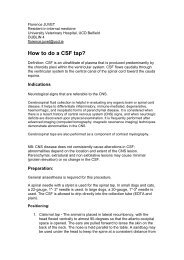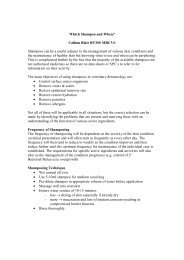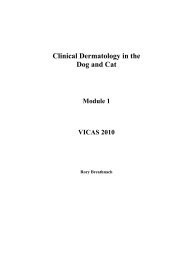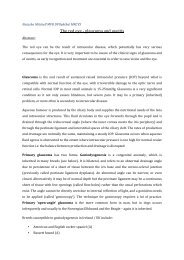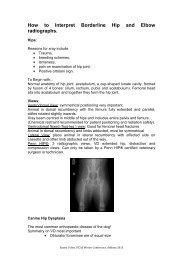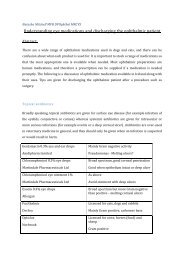TARSOCRURAL LUXATION - Love My Pet
TARSOCRURAL LUXATION - Love My Pet
TARSOCRURAL LUXATION - Love My Pet
- No tags were found...
Create successful ePaper yourself
Turn your PDF publications into a flip-book with our unique Google optimized e-Paper software.
stressing the joint, in both flexion and extension since it is necessary to establish whether one orboth components of each collateral ligament is/are injured.Radiography may be helpful in showing the presence of avulsion fractures and joint spacewidening due to instability, which might require stressed views to become apparent. It may alsoshow the extent of bone loss in "shearing" injuries, although this is usually known after clinicalexamination.TreatmentNon-surgical management is indicated in cases with only partial rupture of a collateral ligamentor an avulsion fracture of a malleolus, which is amenable to closed reduction. The application ofa cast for 6 to 8 weeks may allow satisfactory healing and a return to normal function.Surgical management is indicated in the following situations :-(a) Where avulsion fractures of the medial and/or lateral malleoli are responsible for theinstability and the fragment is considered large enough to accomodate implants. Surgicalmanagement may involve re-attachment of the fragment using a lagged bonescrew or pin and tension band wire.(b) If the injury involves complete rupture of the collateral ligament, and itis treated early, it may be possible to suture the two ends together using anappropriate material such as monofilament nylon or polydioxanone (PDS,Eticon Ltd.). Injuries to the local tendons should also be evaluated andsutured appropriately. Postoperatively, a cast should be applied to the hockfor 6 to 8 weeks.Tarsocrural Luxation - 2



